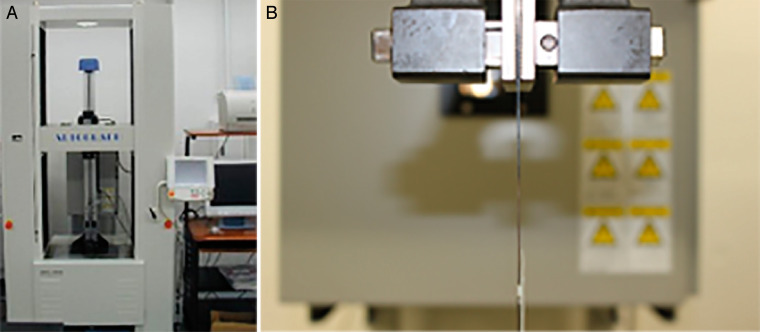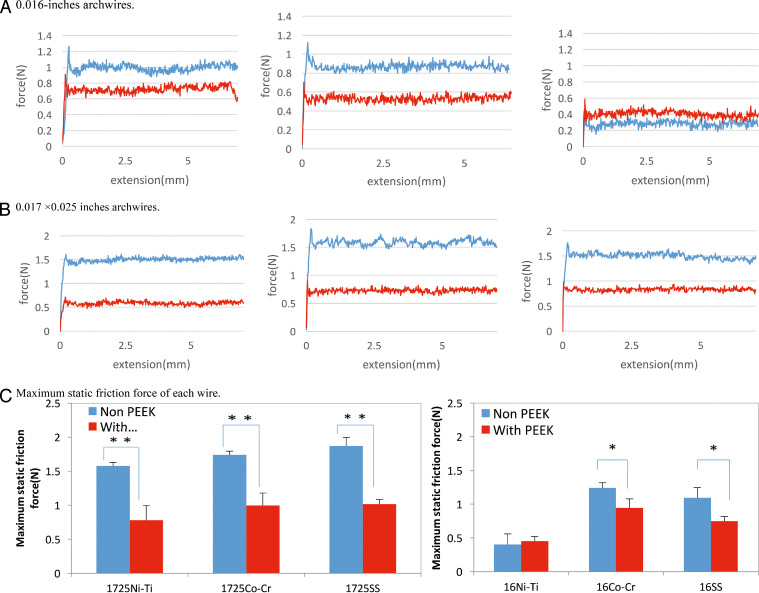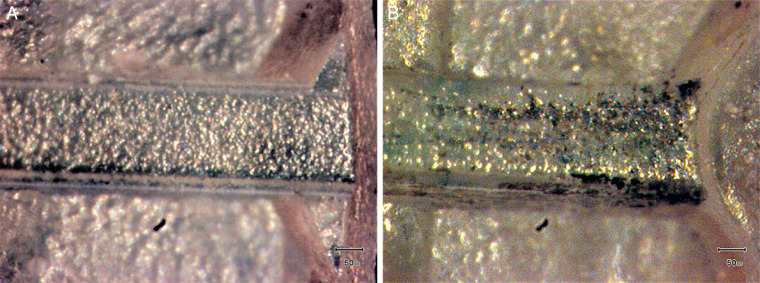Abstract
Objectives:
To evaluate the esthetics and frictional force of an orthodontic wire passed through a newly designed tube made of a polyether ether ketone (PEEK) resin.
Materials and Methods:
Two types of standard PEEK tubes were prepared at 0.5 × 0.6ф and 0.8 × 0.9ф, and different archwires were passed through the tubes. Color values were determined according to brightness and hues. Friction was assessed with different bracket-wire combinations, and surface roughness was determined by stereomicroscopy before and after the application of friction.
Results:
The PEEK tube showed a color difference that was almost identical to that of coated wires conventionally used in clinical practice, indicating a sufficient esthetic property. The result of the friction test showed that the frictional force was greatly reduced by passing the archwire through the PEEK tube in almost all of the archwires tested.
Conclusions:
Use of the new PEEK tube demonstrated a good combination of esthetic and functional properties for use in orthodontic appliances.
Keywords: Polyether ether ketone tube, Superengineering plastics, Orthodontic archwire, Static friction force, Esthetics
INTRODUCTION
The demand for nonmetallic orthodontic materials has increased in recent years. Accordingly, researchers have developed transparent brackets derived from ceramic-based or composite materials to improve the esthetics of orthodontic appliances.1,2 In addition, esthetic archwires made from polymer-coated (Teflon or epoxy resin) alloys as well as glass fiber–reinforced plastic wires have been developed.3,4 These materials were primarily designed to improve the esthetics of the devices, but they can also overcome certain complications of metal-based materials, such as metal allergy and interference with magnetic resonance imaging.5,6 Despite their excellent esthetics, the functional properties of these new materials are inferior to those of metal-based materials. In particular, commonly used metal brackets are composed of stainless steel and have ideal frictional characteristics.7 In addition, some researchers and clinicians have reported difficulties with the use of coated archwires, claiming that they do not have acceptable color stability and that the coating layer tends to split, thereby exposing the underlying substrate metal. For example, resin-coated wires showed friction between the bracket and the wire that was equivalent to or higher than that of the conventional metal wire.8,9 Therefore, development of an orthodontic wire that has a certain esthetic benefit with friction equal to or less than that of a conventional metal wire would be ideal to meet the current clinical demand.
Various plastic materials have been developed for industrial use that could provide superior mechanical and thermal properties compared with conventional plastic. These are known as engineering plastics. Superengineering plastics (SEPs) are widely used owing to their high mechanical strength, with improved thermal and chemical stabilities.10 Among the various types of SEPs, polyether ether ketone (PEEK) shows the highest mechanical strength (tensile and bending). PEEK is a relatively new family of high-temperature thermoplastic polymers, consisting of an aromatic backbone molecular chain interconnected by ketone and ether functional groups. The demand for PEEK has increased recently for several clinical and industrial applications. In medicine, PEEK has proven to be an excellent substitute for titanium in orthopedic applications and has been used in prosthetic dentistry in the form of implants, for provisional abutment, in implant-supported bars, or as a clamp material in the field of removable dental prostheses.11–16
In this study, PEEK was used to develop a new type of orthodontic archwire. An archwire was passed through PEEK to create a tube form (PEEK tube). The esthetic properties, friction between the bracket and wires, and the condition of the base surface of the bracket after friction—using different types of conventional archwires with and without the PEEK cover—were evaluated.
MATERIALS AND METHODS
Materials
The PEEK tube was obtained from Nirei Industry Corporation (Tokyo, Japan), with a tensile modulus of 3 GPa and a tensile stress of 80 MPa.17 As shown in Figure 1, there was almost no difference in the arch form between the archwire passed through a PEEK tube and a pre-formed metal archwire. The archwire could be easily passed through the tube without breaking the arch form by manually bending the tube into the arch form beforehand. Figure 2 shows a model of the dentition with the two types of wires passed through the tube set on the brackets; the upper teeth have a conventionally coated wire, and the lower teeth have the wire that was passed through the PEEK tube. Visual comparison showed the good esthetics of the wire passed through the PEEK tube. Since the coating thickness of the PEEK-coated wire was approximately 0.05 mm, according to the manufacturer, the tube thickness was set to 0.05 mm (0.002 inches) in this study. Two types of standard PEEK tubes were prepared at 0.5 × 0.6ф (tube A) and 0.8 × 0.9ф (tube B). Tube A can accommodate a round wire up to a size of 0.018 inches, and tube B can accommodate a rectangular wire up to 0.0215 × 0.028 inches. Three types of wires were prepared: stainless-steel (SS), cobalt-chromium (Co-Cr), and nickel-titanium (Ni-Ti) superelastic wires with two sizes for each (0.018 inches and 0.017 × 0.025 inches) to pass through the tube. All of the wires could easily slide through the PEEK tube without any resistance. The details of the wires tested in this study are listed in Table 1.
Figure 1.
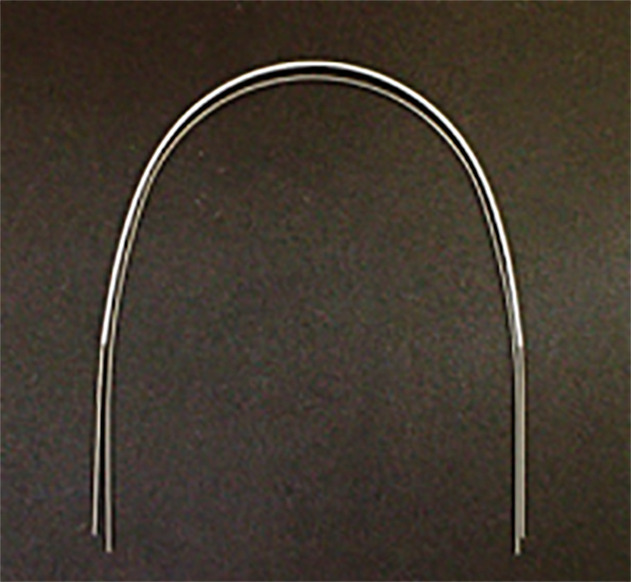
A pre-formed metal archwire and an archwire passed through a PEEK tube, which covers the wire up to the mesial portion of the first molar bracket.
Figure 2.
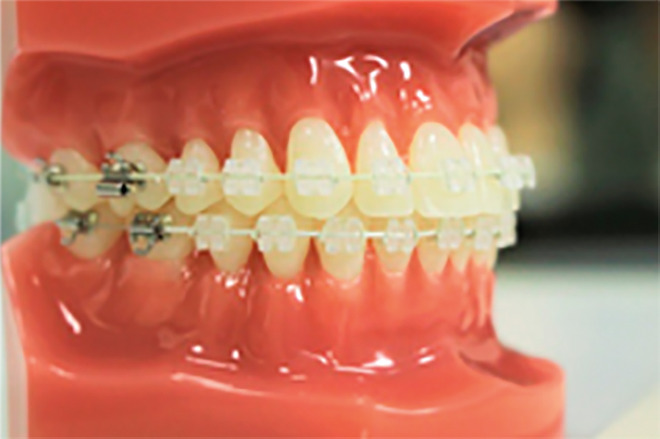
Upper: conventional coated wire; Lower: wire covered by the PEEK tube.
Table 1.
Commercial Orthodontic Wires Tested in this Study
| Common Name |
Abbreviation |
Trade Name |
Manufacturer |
| Stainless steel | SS | SS wire | Orthika International, Tokyo, Japan |
| Co-Cr alloy | Co-Cr | VIM CC(Co-Cr) | Oralcare Tokyo, Japan |
| Ni-Ti alloy | Ni-Ti | G4 Nickel Titanium Archwire | Orthika International, Tokyo, Japan |
| White-coated wire | Ni-Ti | Taini-Roy Wire Nano White | Dentsply Sankin, Tokyo, Japan |
| White-coated wire | Ni-Ti | Ever White | Biodent, Tokyo, Japan |
Color Stability
Color measurements were made with reference to previously reported methods.18 The sample wire with seven tightly arranged segments was fixed with transparent wax at both ends, as shown in Figure 3. The measurements were made on a colorimeter (ShadeEye NCC; Shofu Inc, Kyoto, Japan) using a shade tab (A3, SOLARE; GC Corp, Tokyo, Japan). The color values were compared among the SS wire covered with the PEEK tube, the two types of white-coated wires, the PEEK tube alone, and A1 VITA shades (Vintage shade guide, Shofu Inc). The measurements of the shade guides were made with reference to the bracket position (FA point) in orthodontic treatment. The color values of the wires and shade guides were measured 10 times for each sample, and the average values were recorded.
Figure 3.
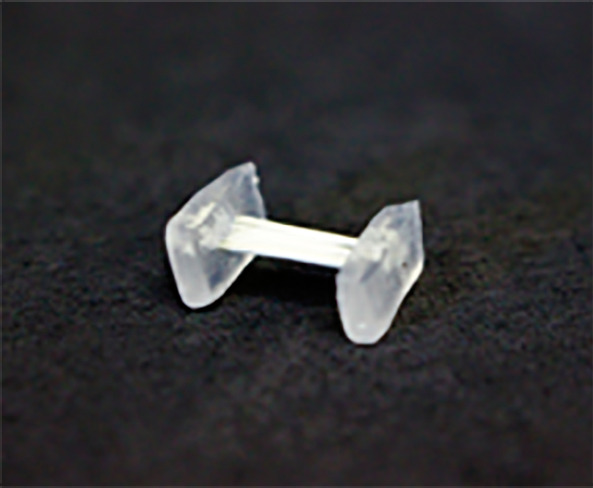
(a) Seven segments tightly arranged and fixed with transparent wax at both ends. (b) The measurement was conducted with a colorimeter using a shade tab.
The color values were characterized using the Commission Internationale de I'Eclairage (CIE) L*a*b* color space, which is a three-dimensional color space, in which the three axes are L*, a*, and b*, respectively. The L* value is a measure of the lightness of an object and is quantified on a scale such that a perfect black has an L* value of 0 and a perfect reflecting diffuser has an L* value of 100. The a* value is a measure of the redness (+a*) or greenness (−a*) of an object, while the b* value is a measure of the yellowness (+b*) or blueness (−b*) of an object. The color was assessed as a quantitative rectangular coordinate system to allow for objective color measurement, which adequately represented the visual perception of color differences. Total color differences re expressed by the formula ΔE* = ([ΔL*]2 + [Δa*]2 + [Δb*]2)1/2, where ΔL*, Δa*, and Δb* are differences in L*, a*, and b* values, respectively, between VITA A1 and each archwire. To relate the amount of color change (ΔE*) to the clinical environment, the data were converted to National Bureau of Standards (NBS) units,19 shown in Table 2.
Table 2.
Critical Markers of Color Change According to the National Bureau Standards (NBS)
| NBS Unit Definitions of Color Differences |
| 0.0–0.5 Trace extremely slight change |
| 0.5–1.5 Slight slight change |
| 1.5–3.0 Noticeable perceivable change |
| 3.0–6.0 Appreciable marked change |
| 6.0–12.0 Much extremely marked change |
| 12.0+ Very much change to other color |
Friction Test
The static friction force generated with each bracket-wire combination was measured under dry conditions and at room temperature (25°C) using a universal testing machine (AG, I 100 kN; Shimadzu, Kyoto, Japan), according to the method described in previous reports.20–22 Each bracket was bonded to a SS plate that could provide 0° bracket torque and 0° angulation with the aid of a bracket-mounting device that employed an unfilled adhesive resin (Superbond, Sun Medical, Shiga, Japan). The SS plate with the bracket was attached to the friction-testing device, and a 5-cm segment of wire obtained from the posterior straight portions of the archwires was then fixed to each part ligated to the conventional bracket using an elastomeric module (TP elastomer, TP Orthodontics Japan, Tokyo, Japan), as shown in Figure 4A and B. The tube and bracket were ligated and fixed, and only the wire passing through it was able to slide, as shown in Figure 5. The upper end of the wire was then fixed to a 150-g weight, and each wire was drawn through the bracket at a crosshead speed of 10 mm/min for a distance of 5 mm. The static frictional force was then determined from the load-displacement curves. Each combination of bracket and wire was measured 10 times.
Figure 4.
Friction testing device. The stainless-steel plate with the bracket was attached to the friction-testing device (A: left); a 5-cm segment of wire (B: right) obtained from the posterior straight portion of the archwire was tested.
Figure 5.
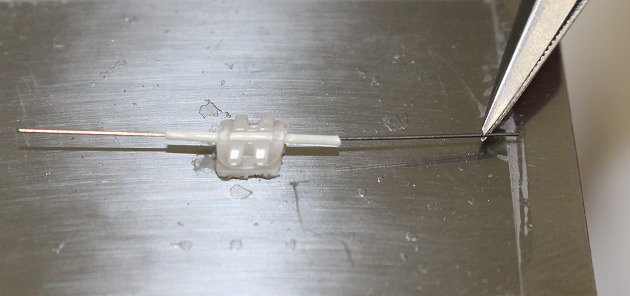
The tube and bracket are ligated and fixed, only the wire passing through the tube slides.
Surface Roughness of a Bracket Slot
The bracket slot was observed under a stereomicroscope (SZH-ILLB; Olympus, Tokyo, Japan) at 60× magnification before and after the friction tests.
Statistical Analysis
Statistical analyses were performed using SPSS version 16.0J for Windows (IBM Japan, Tokyo, Japan) software. The mean and standard deviation of the static friction values were calculated, and the results for the covered and noncovered archwires were compared by a t-test.
RESULTS
Color Stability
The ΔE* value of PEEK alone was very high but showed the same value as Nano white when the SS wire was passed through PEEK (Table 3).
Table 3.
Color Stability Values Converted to National Bureau of Standards (NBS) Unitsa
| Wire Type |
Mean ΔE* (Standard Deviation)b |
NBS Unitsc |
| PEEK alone | 11.47 (0.19) | 10.55 |
| SS wire covered with the PEEK tube | 8.82 (0.4) | 8.11 |
| Nano White | 8.59 (0.38) | 7.90 |
| Ever White | 7.04 (0.15) | 6.47 |
PEEK indicates polyether ether ketone; SS, stainless steel.
The total color differences (ΔE*) values were calculated according to the formula ΔE* = ([ΔL*]2 + [Δa*]2 + [Δb*]2)1/2, which represents the color difference between VITA A1 and each archwire.
NBS units = ΔE* × 0.92. The definitions of color changes quantified by NBS units were used.
Friction Test
The static friction force values of each wire with and without covering of the PEEK tube are shown in Table 4. There was no significant difference for the 0.016-inch Ni-Ti wire with and without PEEK (P > .05). However, the SS and Co-Cr wires had significantly lower friction values when covered with the PEEK tube (P < .05). All three wire types of 0.017 × 0.025 inches also showed significantly lower friction values when covered by the PEEK tube (P < .01). The kinetic frictional force was also decreased for each wire that showed a reduction in the static frictional force by covering with the PEEK tube (Figure 6).
Table 4.
Friction Force (N) Values (Mean ± Standard Deviation)a
| Wire |
Non–PEEK Tube |
With PEEK Tube |
P-Value |
| 0.016-inch Ni-Ti | 0.401 ± 0.19 | 0.451 ± 0.063 | .53 |
| 0.016-inch Co-Cr | 1.24 ± 0.08 | 0.94 ± 0.108 | <.05 |
| 0.016-inch SS | 1.09 ± 0.21 | 0.746 ± 0.096 | <.05 |
| 0.017 × 0.025-inch Ni-Ti | 1.574 ± 0.034 | 0.78 ± 0.301 | <.01 |
| 0.017 × 0.025-inch Co-Cr | 1.741 ± 0.061 | 0.99 ± 0.294 | < 0.01 |
| 0.017 × 0.025-inch SS | 1.87 ± 0.145 | 0.91 ± 0.033 | < 0.01 |
PEEK indicates polyether ether ketone; Ni-Ti, nickel-titanium; Co-Cr, cobalt-chromium; and SS, stainless steel.
Figure 6.
Friction test results for the (a) 0.016-inch and (b) 0.017 × 0.025-inch wires. Blue indicates no tubes, red indicates wires covered with tubes. (c) Maximum static friction force of each wire. The measured value represents the average of five experiments. * Significant difference at P < .05; ** Significant difference at P < .01.
Surface Roughness of a Bracket Slot
The stereomicroscope images of the bracket slot taken after the friction test are shown in Figure 7A and B. There was barely any change detected in the surface roughness of a wire covered by the PEEK tube following the friction force test. However, in the wire not covered by the PEEK tube, several scratches were evident in the bracket slot due to contact with the wire.
Figure 7.
The state of the base surface of the bracket slot after the friction test for the PEEK-covered wire (A: left) and the non–PEEK-covered wire (B: right); magnification 60×.
DISCUSSION
During tooth movement, the friction between the bracket and the archwire is a primary concern.23,24 The main factors that affect frictional resistance include the type of bracket; the physical properties, size, and alloy of the archwires; and the method of ligation.25–31 Several methods have been proposed for reducing the friction between the brackets and wire, including the use of surface treatments such as ion implantation, poly(tetrafluoroethylene) coating, and diamond-like carbon coatings of the wires and/or brackets.32–34 In orthodontic clinical practice, the coating on the wire is associated with certain problems, such as peeling, and the coating on the bracket slot shows poor durability. With this background, and considering the increasing demand for orthodontic materials with improved esthetics, an orthodontic wire was developed by preparing a standard tube using PEEK resin, which has particularly excellent mechanical properties among the known SEPs.
Consideration of the loss of force due to friction is necessary for optimal clinical tooth movement. Kusy and Whitley35 showed that 12–60% of the orthodontic force can be reduced by friction throughout the course of orthodontic treatment. The results of the friction test in this study showed that the frictional force was greatly reduced by passing the archwire through the PEEK tube in almost all of the archwires tested. These results suggest that force reduction is a requirement for optimal and efficient tooth movement.
The archwire should easily slide through the bracket slots to be level and align with misaligned teeth more efficiently.36 It was hypothesized that passing a wire through a tube would result in a decrease in frictional force because of the lower coefficient of friction between PEEK and wires compared to that of a conventional bracket-wire interaction. Indeed, the friction test showed that the PEEK tube can result in more efficient leveling and alignment in orthodontic treatment. Although friction is related to any stage of orthodontic treatment, use of a PEEK tube can exert a strong effect in reducing friction as much as possible.
In addition, the surface condition of the bracket slot was maintained in its initial state by covering the archwire with the PEEK tube. By contrast, with conventional metal wires, as treatment progresses, continuous friction against the bracket slots results in accumulated damage, and, thus, the slot dimensions cannot maintain the definite square shape established at the start of the treatment. Plastic deformation of the bracket slot also increases the torque play.37 The change of the dimension of the bracket slot increases the slot play between the bracket and the wire, which makes it more difficult to achieve torque control of the tooth. The dimensions of the slot can be maintained in the initial state by using the PEEK tube and can prevent an increase in slot play.
In current clinical orthodontic practice, orthodontic appliances are required to have high esthetic properties. In recent years, there have been several studies on a wide array of esthetic correction devices with clinical relevance. Ideally, the color of esthetic archwires should match that of the natural teeth with esthetically pleasing brackets. However, the natural tooth color used for the design of these materials can vary substantially according to the color measurement protocols used as well as across populations according to race, gender, and age.38,39
The recent development and commercialization of colored PEEK products is impressive. In this study, the newly developed PEEK tube showed a color difference that was almost identical to that of the coated wires that are currently used clinically. However, in order to better approximate the natural color of the teeth, the color of the PEEK tube should be further optimized.
CONCLUSIONS
Previous research40 has demonstrated the high-quality physical properties of PEEK. A PEEK tube was developed as an auxiliary device to help make orthodontic treatment more efficient and to satisfy consumer esthetic demands. The results of this study suggest that the application of PEEK to orthodontic devices is realistic and clinically meaningful.
Nevertheless, more studies are needed to determine the physical properties when PEEK is processed to tube specifications. Future development of the PEEK tube as an orthodontic appliance is expected to show excellent performance in strength, esthetics, and friction reduction.
ACKNOWLEDGMENT
The authors acknowledge Nirei Industry Corporation for support in preparing the polyether ether ketone tube in this study.
REFERENCES
- 1.Yu B, Lee YK. Aesthetic color performance of plastic and ceramic brackets—an in vitro study. J Orthod. 2011;38:167–174. doi: 10.1179/14653121141434. [DOI] [PubMed] [Google Scholar]
- 2.Lee YK. Color and translucency of tooth-colored orthodontic brackets. Eur J Orthod. 2008;30:205–210. doi: 10.1093/ejo/cjm122. [DOI] [PubMed] [Google Scholar]
- 3.Elayyan F, Silikas N, Bearn D. Ex vivo surface and mechanical properties of coated orthodontic archwires. Eur J Orthod. 2008;30:661–667. doi: 10.1093/ejo/cjn057. [DOI] [PubMed] [Google Scholar]
- 4.Ohtonen J, Vallittu PK, Lassila LVJ. Effect of monomer composition of polymer matrix on flexural properties of glass fibre-reinforced orthodontic archwire. Eur J Orthod. 2013;35:110–114. doi: 10.1093/ejo/cjr128. [DOI] [PubMed] [Google Scholar]
- 5.Kusy RP. A review of contemporary archwires: their properties and characteristics. Angle Orthod. 1997;67:197–207. doi: 10.1043/0003-3219(1997)067<0197:AROCAT>2.3.CO;2. [DOI] [PubMed] [Google Scholar]
- 6.Imai H, Tanaka Y, Nomura N, et al. Three-dimensional quantification of susceptibility artifacts from various metals in magnetic resonance images. Acta Biomater. 2013;9:8433–8439. doi: 10.1016/j.actbio.2013.05.017. [DOI] [PubMed] [Google Scholar]
- 7.Kusy RP, Whitely JQ, Prewitt MJ. Comparison of the frictional coefficients for selected archwire-bracket slot combinations in the dry and wet states. Angle Orthod. 1991;61:293–302. doi: 10.1043/0003-3219(1991)061<0293:COTFCF>2.0.CO;2. [DOI] [PubMed] [Google Scholar]
- 8.Mugumura T, Iijima M, Yuasa T, Kawaguchi K, Mizoguchi I. Characterization of the coatings covering esthetic orthodontic archwires and their influence on the bending and frictional properties. Angle Orthod. 2017;37:610–617. doi: 10.2319/022416-161.1. [DOI] [PMC free article] [PubMed] [Google Scholar]
- 9.Kim Y, Cha JY, Hwang CJ, Yu HS, Tahk SG. Comparison of frictional forces between aesthetic orthodontic coated wires and self-ligation brackets. Korean J Orthod. 2014;44:157–167. doi: 10.4041/kjod.2014.44.4.157. [DOI] [PMC free article] [PubMed] [Google Scholar]
- 10.San FGB, Tekin G. A review of thermoplastic composites for bipolar plate applications. Int J Energy Res. 2013;37:283–309. [Google Scholar]
- 11.Kurtz SM, Devine JN. PEEK biomaterials in trauma, orthopedic, and spinal implants. Biomaterials. 2007;28:4845–4869. doi: 10.1016/j.biomaterials.2007.07.013. [DOI] [PMC free article] [PubMed] [Google Scholar]
- 12.Toth JM, Wang M, Estes BT, Scifert JL, Seim HB, III, Turner AS. Polyetheretherketone as a biomaterial for spinal applications. Biomaterials. 2006;27:324–334. doi: 10.1016/j.biomaterials.2005.07.011. [DOI] [PubMed] [Google Scholar]
- 13.Tetelman ED, Babbush CA. A new transitional abutment for immediate aesthetics and function. Implant Dent. 2008;17:51–58. doi: 10.1097/ID.0b013e318167648c. [DOI] [PubMed] [Google Scholar]
- 14.Santing HJ, Meijer HJ, Raghoebar GM, Ozcan M. Fracture strength and failure mode of maxillary implant-supported provisional single crowns: a comparison of composite resin crowns fabricated directly over PEEK abutments and solid titanium abutments. Clin Implant Dent Relat Res. 2012;14:882–889. doi: 10.1111/j.1708-8208.2010.00322.x. [DOI] [PubMed] [Google Scholar]
- 15.Bayer S, Komor N, Kramer A, Albrecht D, Mericske-Stern R, Enkling N. Retention force of plastic clips on implant bars: a randomized controlled trial. Clin Oral Implants Res. 2012;23:1377–1384. doi: 10.1111/j.1600-0501.2011.02312.x. [DOI] [PubMed] [Google Scholar]
- 16.Tannous F, Steiner M, Shahin R, Kern M. Retensive forces and fatigue resistance of thermoplastic resin clasps. Dent Mater. 2012;28:273–278. doi: 10.1016/j.dental.2011.10.016. [DOI] [PubMed] [Google Scholar]
- 17.Sandler J, Werner P, Shaffer M, Demchuk V, Alstädt V, Windle AH. Carbon-nanofibre-reinforced poly(ether ether ketone) composites. Compos Part A Appl S. 2002;33:1033–1039. [Google Scholar]
- 18.da Silva DL, Mattos CT, de Araujo MV, de Oliveira Ruellas AC. Color stability and fluorescence of different orthodontic archwires. Angle Orthod. 2013;83:127–132. doi: 10.2319/121311-764.1. [DOI] [PMC free article] [PubMed] [Google Scholar]
- 19.Nimeroff I. Colorimetry. Natl Bureau Stand Monogr. 1968;47:104. [Google Scholar]
- 20.Redlich M, Mayer Y, Harari D, Lewinstein I. In vitro study of frictional forces during sliding mechanics of “reduced-friction” brackets. Am J Orthod Dentofacial Orthop. 2003;124:69–73. doi: 10.1016/s0889-5406(03)00238-5. [DOI] [PubMed] [Google Scholar]
- 21.Muguruma T, Iijima M, Brantley WA, Mizoguchi I. Effects of a diamond-like carbon coating on the frictional properties of orthodontic wires. Angle Orthod. 2011;81:141–148. doi: 10.2319/052110-276.1. [DOI] [PMC free article] [PubMed] [Google Scholar]
- 22.Cha JY, Kim KS, Hwang CJ. Friction of conventional and silica-insert ceramic brackets in various bracket-wire combinations. Angle Orthod. 2007;77:100–107. doi: 10.2319/092705-333R.1. [DOI] [PubMed] [Google Scholar]
- 23.Burrow SJ. Friction and resistance to sliding in orthodontics: a critical review. Am J Orthod Dentofacial Orthop. 2009;135:442–447. doi: 10.1016/j.ajodo.2008.09.023. [DOI] [PubMed] [Google Scholar]
- 24.Muguruma T, Iijima M, Brantley WA, Ahluwalia KS, Kohda N, Mizoguchi I. Effects of third-order torque on frictional force of self-ligating brackets. Angle Orthod. 2014;84:1054–1061. doi: 10.2319/111913-845.1. [DOI] [PMC free article] [PubMed] [Google Scholar]
- 25.Eslamian L, Borzabadi-Farahani A, Mousavi N, Ghasemi A. A comparative study of shear bond strength between metal and ceramic brackets and artificially aged composite restorations using different surface treatments. Eur J Orthod. 2012;34:610–617. doi: 10.1093/ejo/cjr044. [DOI] [PubMed] [Google Scholar]
- 26.De Franco DJ, Spiller RE, Jr, von Fraunhofer JA. Frictional resistances using Teflon-coated ligatures with various bracket-archwire combinations. Angle Orthod. 1995;65:63–72. doi: 10.1043/0003-3219(1995)065<0063:FRUTLW>2.0.CO;2. [DOI] [PubMed] [Google Scholar]
- 27.Saunders CR, Kusy RP. Surface topography and frictional characteristics of ceramic brackets. Am J Orthod Dentofacial Orthop. 1994;106:76–87. doi: 10.1016/S0889-5406(94)70024-9. [DOI] [PubMed] [Google Scholar]
- 28.Guerrero AP, Guariza Filho O, Tanaka O, Camargo ES, Vieira S. Evaluation of frictional forces between ceramic brackets and archwires of different alloys compared with metal brackets. Braz Oral Res. 2010;24:40–45. doi: 10.1590/s1806-83242010000100007. [DOI] [PubMed] [Google Scholar]
- 29.Williams CL, Khalaf K. Frictional resistance of three types of ceramic brackets. J Oral Maxillofac Res. 2013;4:e3. doi: 10.5037/jomr.2013.4403. [DOI] [PMC free article] [PubMed] [Google Scholar]
- 30.Omana HM, Moore RN, Bagby MD. Frictional properties of metal and ceramic brackets. J Clin Orthod. 1992;26:425–432. [PubMed] [Google Scholar]
- 31.Keith O, Jones SP, Davies EH. The influence of bracket material, ligation force and wear on frictional resistance of orthodontic brackets. Br J Orthod. 1993;20:109–115. doi: 10.1179/bjo.20.2.109. [DOI] [PubMed] [Google Scholar]
- 32.Kusy RP, Tobin EJ, Whitley JQ, Sioshansi P. Frictional coefficients of ion-implanted alumina against ion-implanted beta-titanium in the low load, low velocity, single pass regime. Dent Mater. 1992;8:167–172. doi: 10.1016/0109-5641(92)90076-o. [DOI] [PubMed] [Google Scholar]
- 33.Farronato G, Maijer R, Carìa MP, Esposito L, Alberzoni D, Cacciatore G. The effect of Teflon coating on the resistance to sliding of orthodontic archwires. Eur J Orthod. 2012;34:410–417. doi: 10.1093/ejo/cjr011. [DOI] [PubMed] [Google Scholar]
- 34.Akaike S, Hayakawa T, Kobayashi D, et al. Reduction in static friction by deposition of a homogeneous diamond-like carbon (DLC) coating on orthodontic brackets. Dent Mater J. 2015;34:888–895. doi: 10.4012/dmj.2015-130. [DOI] [PubMed] [Google Scholar]
- 35.Kusy RP, Whitley JQ. Friction between different wire-bracket configurations and materials. Semin Orthod. 1997;3:166–177. doi: 10.1016/s1073-8746(97)80067-9. [DOI] [PubMed] [Google Scholar]
- 36.Damon DH. The Damon low-friction bracket: a biologically compatible straight-wire system. J Clin Orthod. 1998;32:670–680. [PubMed] [Google Scholar]
- 37.Major TW, Carey JP, Nobes DS, Heo G, Major PW. Deformation and warping of the bracket slot in select self-ligating orthodontic brackets due to an applied third order torque. J Orthod. 2012;39:25–33. doi: 10.1179/14653121226797. [DOI] [PubMed] [Google Scholar]
- 38.Bolt RA, Bosch JJ, Coops JC. Influence of window size in small-window color measurements, particularly of teeth. Phys Med Biol. 1994;39:1133–1142. doi: 10.1088/0031-9155/39/7/006. [DOI] [PubMed] [Google Scholar]
- 39.Li Y. Tooth color measurement using Chroma Meter: techniques, advantages, and disadvantages. J Esthet Restor Dent. 2003;15:S33–S41. doi: 10.1111/j.1708-8240.2003.tb00316.x. [DOI] [PubMed] [Google Scholar]
- 40.Maekawa M, Kanno Z, Wada T, et al. Mechanical properties of orthodontic wires made of super engineering plastic. Dent Mater J. 2015;34:114–119. doi: 10.4012/dmj.2014-202. [DOI] [PubMed] [Google Scholar]



